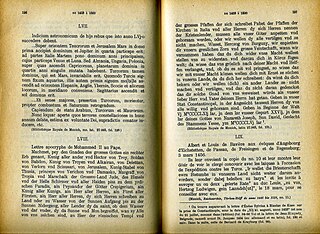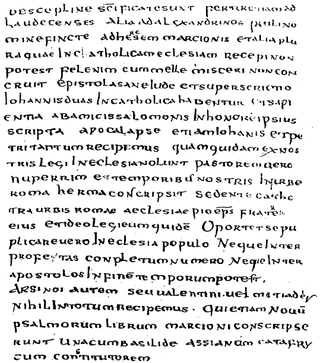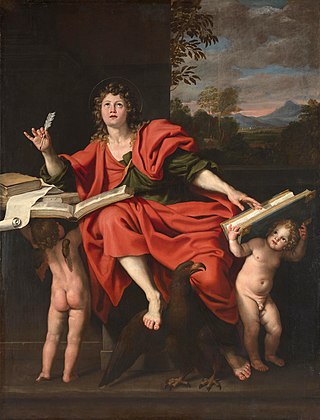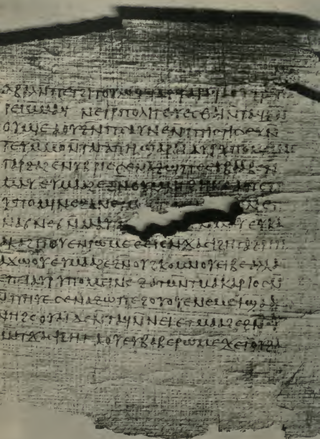
Apocrypha are biblical or related writings not forming part of the accepted canon of Scripture. While some might be of doubtful authorship or authenticity, in Christianity, the word apocryphal (ἀπόκρυφος) was first applied to writings which were to be read privately rather than in the public context of church services. Apocrypha were edifying Christian works that were not considered canonical scripture. It was not until well after the Protestant Reformation that the word apocrypha was used by some ecclesiastics to mean "false," "spurious," "bad," or "heretical."
The New Testament (NT) is the second division of the Christian biblical canon. It discusses the teachings and person of Jesus, as well as events relating to first-century Christianity. The New Testament's background, the first division of the Christian Bible, is called the Old Testament, which is based primarily upon the Hebrew Bible; together they are regarded as Sacred Scripture by Christians.

The Second Epistle of Peter is an epistle of the New Testament, and it identifies the author as "Simon Peter, a bondservant and apostle of Jesus Christ". The epistle is traditionally attributed to Peter the Apostle, but most scholars consider the epistle pseudepigraphical Scholars estimate the date of authorship anywhere from 60 to 150 AD. The original text was written in Koine Greek.

An epistle is a writing directed or sent to a person or group of people, usually an elegant and formal didactic letter. The epistle genre of letter-writing was common in ancient Egypt as part of the scribal-school writing curriculum. The letters in the New Testament from Apostles to Christians are usually referred to as epistles. Those traditionally attributed to Paul are known as Pauline epistles and the others as catholic epistles.

The Epistle of Barnabas is a Greek epistle written between AD 70 and 132. The complete text is preserved in the 4th-century Codex Sinaiticus, where it appears immediately after the New Testament and before the Shepherd of Hermas. For several centuries it was one of the "antilegomena" ("disputed") writings that some Christians looked on as sacred scripture, while others excluded them. Eusebius of Caesarea classified it with excluded texts. It is mentioned in a perhaps third-century list in the sixth-century Codex Claromontanus and in the later Stichometry of Nicephorus appended to the ninth-century Chronography of Nikephoros I of Constantinople. Some early Fathers of the Church ascribed it to the Barnabas who is mentioned in the Acts of the Apostles, but it is now generally attributed to an otherwise unknown early Christian teacher, although some scholars do defend the traditional attribution. It is distinct from the Gospel of Barnabas.

The Muratorian fragment, also known as the Muratorian Canon, is a copy of perhaps the oldest known list of most of the books of the New Testament. The fragment, consisting of 85 lines, is a Latin manuscript bound in a roughly 8th-century codex from the library of Columbanus's monastery at Bobbio Abbey; it contains features suggesting it is a translation from a Greek original written in the late 2nd century. Other scholars suggest it might have been originally written as late as the 4th century, although this is not the consensus opinion. Both the degraded condition of the manuscript and the poor Latin in which it was written have made it difficult to translate. The beginning of the fragment is missing, and it ends abruptly. The fragment consists of all that remains of a section of a list of all the works that were accepted as canonical by the churches known to its original compiler.

Pseudepigrapha are falsely attributed works, texts whose claimed author is not the true author, or a work whose real author attributed it to a figure of the past. The name of the author to whom the work is falsely attributed is often prefixed with the particle "pseudo-", such as for example "pseudo-Aristotle" or "pseudo-Dionysius": these terms refer to the anonymous authors of works falsely attributed to Aristotle and Dionysius the Areopagite, respectively.
The Apostolic Fathers, also known as the Ante-Nicene Fathers, were core Christian theologians among the Church Fathers who lived in the 1st and 2nd centuries AD who are believed to have personally known some of the Twelve Apostles or to have been significantly influenced by them. Their writings, though widely circulated in early Christianity, were not included in the canon of the New Testament. Many of the writings derive from the same time period and geographical location as other works of early Christian literature which came to be part of the New Testament.

The authorship of the Johannine works has been debated by biblical scholars since at least the 2nd century AD. The debate focuses mainly on the identity of the author(s), as well as the date and location of authorship of these writings.

The Third Epistle to the Corinthians is an early Christian text written by an unknown author claiming to be Paul the Apostle. It is also found in the Acts of Paul, and was framed as Paul's response to a letter of the Corinthians to Paul. The earliest extant copy is Papyrus Bodmer X, dating to the third century. Originally written in Koine Greek, the letter survives in Greek, Coptic, Latin, and Armenian manuscripts.

The Acts of Paul is one of the major works and earliest pseudepigraphal series from the New Testament apocrypha also known as Apocryphal Acts. This work is part of a body of literature either about or purporting to be written by Paul the Apostle, including letters, narratives, prayers, and apocalypses. An approximate date given to the Acts of Paul is 100-160 AD. The Acts of Paul were first mentioned by Tertullian, who deemed the work to be heretical. He mentioned that that the writings "wrongly go under Paul's name" and was "augmenting Paul's fame from his own store". Eusebius wrote than, unlike other writings which were classified as antilegomena in some instances, the Acts of Paul were always classified among the disputed. The Acts of Paul may have been considered orthodox by Hippolytus of Rome but were eventually regarded as heretical when the Manichaeans started using the texts. The author of the Acts of Paul is unknown, but probably came from a Christian community in Asia Minor that revered Paul. The work does not use the canonical Acts of the Apostles as a source; instead it relies on oral traditions of Paul's missionary work. The text is primarily known from Greek manuscripts. The discovery of a Coptic language version of the text demonstrated that the text was composed of:

The Epistle of the Apostles is a work of New Testament apocrypha. Despite its name, it is more a gospel or an apocalypse than an epistle. The work takes the form of an open letter purportedly from the remaining eleven apostles describing key events of the life of Jesus, followed by a dialogue between the resurrected Jesus and the apostles where Jesus reveals apocalyptic secrets of reality and the future. It is 51 chapters long. The epistle was likely written in the 2nd century CE in Koine Greek, but was lost for many centuries. A partial Coptic language manuscript was discovered in 1895, a more complete Ethiopic language manuscript was published in 1913, and a full Coptic-Ethiopic-German edition was published in 1919.
Antilegomena are written texts whose authenticity or value is disputed. Eusebius in his Church History used the term for those Christian scriptures that were "disputed", literally "spoken against", in Early Christianity before the closure of the New Testament canon.
The Lost Books of the Bible and the Forgotten Books of Eden (1926) is a collection of 17th-century and 18th-century English translations of some Old Testament Pseudepigrapha and New Testament Apocrypha, some of which were assembled in the 1820s, and then republished with the current title in 1926.
The authorship of the Petrine epistles is a question in biblical criticism, parallel to that of the authorship of the Pauline epistles, in which scholars have sought to determine the exact authors of the New Testament letters. The vast majority of biblical scholars think the two epistles do not share the same author, due to wide differences in Greek style and views between the two letters. Most scholars today conclude that Peter the Apostle was the author of neither of the two epistles that are attributed to him.
A biblical canon is a set of texts which a particular Jewish or Christian religious community regards as part of the Bible.
The canon of the New Testament is the set of books many modern Christians regard as divinely inspired and constituting the New Testament of the Christian Bible. For most churches, the canon is an agreed-upon list of 27 books that includes the canonical Gospels, Acts, letters attributed to various apostles, and Revelation.

Infancy gospels are a genre of religious texts that arose in the 2nd century. They are part of New Testament apocrypha, and provide accounts of the birth and early life of Jesus. The texts are of various and uncertain origin, and are generally non-canonical in major modern branches of Christianity. They include the Gospel of James, which introduces the concept of the Perpetual Virginity of Mary, and the Infancy Gospel of Thomas, both of which cover many miraculous incidents from the life of Mary and the childhood of Jesus that are not included in the canonical gospels. Although the Life of John the Baptist focuses on John the Baptist rather than Jesus or his immediate family, it is also included in the genre as its events would be contemporary with Jesus's early life.
Passion Gospels are early Christian texts that either mostly or exclusively relate to the last events of Jesus' life: the Passion of Jesus. They are generally classed as New Testament apocrypha. The last chapters of the four canonical gospels include Passion narratives, but later Christians hungered for more details. Just as infancy gospels expanded the stories of young Jesus, Passion Gospels expanded the story of Jesus's arrest, trial, execution, resurrection, and the aftermath. These documents usually claimed to be written by a participant mentioned in the gospels, with Nicodemus, Pontius Pilate, and Joseph of Arimathea as popular choices for author. These documents are considered more legendary than historical, however, and were not included in the eventual Canon of the New Testament.








